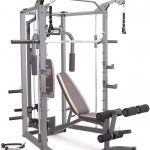Table of Contents
The Smith Machine Bench Press and Barbell Bench Press are two popular exercises for developing chest and upper body strength. This article discusses the differences between the two exercises and the potential benefits of each. Learn about the pros and cons of each exercise and how to choose the best one for your fitness goals.
The Smith machine is most likely one of your gym’s most underutilized, underappreciated, and underrated equipment!
While it isn’t as flexible or adaptable as most other equipment, the steadiness and fixed movement it provides might aid you in more ways than you think.
I had so much fun comparing squats using a Smith machine versus a squat rack that I decided to produce another similar piece, this time comparing bench presses using the Smith machine to the all-time superstar: the barbell bench press.
Prepare for an in-depth examination of the two exercises as I analyze their benefits, downsides, similarities, and differences—and, of course, address the most often-asked questions regarding Smith machine bench presses.
Complete Comparison Table of Smith Machine Bench Press vs Barbell Bench Press
| Comparisons | Smith Machine Bench Press | Barbell Bench Press |
| 1 | Fixed bar path | Free weight movement path |
| 2 | Smaller range of motion | Greater range of motion |
| 3 | Ideal for beginners | Ideal for experienced weightlifters |
| 4 | Less form adjustments required | More form adjustments required |
| 5 | Less risk of injury | Greater risk of injury |
| 6 | Ideal for isolation exercises | Ideal for compound exercises |
| 7 | Allows for partial reps | Allows for full reps |
| 8 | Little to no use of stabilizer muscles | Requires use of stabilizer muscles |
Let’s get started.
Overview of the Barbell Bench Press
The bench press is the finest recruiter of your pectoral muscles and a measure of chest, triceps, and shoulder strength.
Buy Barbell Bench Press Online
It’s the “superstar” for a variety of reasons, the most important of which are:
- Maximum power acquisition. Because you’re below the weight, you can utilize all of your chest, shoulder, and tricep muscles to propel yourself upward.
- The ability to move freely. The barbell is free to move, enabling you to find the ideal position/form for your joints and natural range of motion while also utilizing your secondary stabilizer muscles to maintain the weight going smoothly up and down.
How to Clean Dumbbells and Weights at Home?
Of course, it has several downsides, the most significant of which is:
- The danger to one’s safety. Because the weight is free, you run the danger of tipping to one side or losing your equilibrium. You could also become stuck if you’re working with an overloaded barbell and no spotter—you simply can’t pull it all the way up to re-rack it in its cradle, which can be deadly! And, of course, since the weight is floating free (only supported by your muscles), you face the danger of poor posture/form, which may lead to injury (particularly in your rotator cuff and chest).
Overview of the Smith Machine Bench Press
The Smith machine bench press uses the same workout structure as the barbell and dumbbell bench presses; however, it is performed on a fixed-track Smith machine.
Buy Smith Machine Bench Press Online
I like the Smith machine bench press for a number of reasons:
- It’s more secure. It’s a really safe workout since the Smith machine bar weight is moving up and down a track with a multitude of cradles the bar may latch into. If you’re struggling or can’t achieve that one final rep, just racks the bar and finish your set early, with no straining or jerking required and no chance of crushing yourself under a heavy barbell.
- It’s really stable. Tipping over, falling, losing your balance, or slipping off the bench is no danger. The barbell can only travel in one direction (up and down), and the track supports your weight throughout the whole range of motion.
Body-Solid SDRS Dumbbell Review: Design & Build Quality
Of course, there is one major disadvantage to using the Smith machine bench press:
- It does not permit freedom of movement. Because the barbell is sliding along a fixed plane of motion, minute modifications to angle and trajectory are not possible to address joint difficulties. You won’t be able to compensate if your elbows, wrists, or shoulders aren’t moving as freely as they should (due to injury or stiffness).
Differences Between Smith Machine Bench Press vs Barbell Bench Press
While the two workouts are basically similar (you’re laying on a bench and pushing a big weight upward—Woop Woop! ), there are a few key distinctions between them, as seen by the advantages and negatives outlined above.
These distinctions are partly responsible for the Smith machine bench press’s widespread ridicule in the weightlifting world, whereas the Olympic barbell bench press is regarded as the “hero.”
-
Fixed Plane of Movement vs. Free Plane of Movement
Pushing the barbell on the Smith machine bench press can only go one way: up. The weight can only fall straight down when you relax.
The plane of movement is fixed since the weight is attached to a sliding rack.
As previously stated, this might be restrictive for people who have joint issues or are recuperating from an accident.
If you don’t get your bench, body, and hands JUST RIGHT, the exercise may feel strange, stiff, or unnatural.
However, with barbell bench presses, you only need to hold the weight steady/stable while pushing. You have more flexibility of movement with a free weight so that you can adjust for joint and muscle insufficiencies more efficiently.
-
Muscle Isolation
Muscle isolation is one of the primary distinctions between the Smith machine bench press and the barbell bench press.
When bench-pressing with a barbell, your secondary stabilizer muscles contract to maintain the barbell stable throughout the whole range of motion. This improves total functional fitness and builds strength in muscles other than those targeted by the bench press.
Yes, this is a nice thing—but it is not the sole training method. Muscle isolation workouts, although not perfect for general fitness, are excellent for developing true power and triggering significant size growth in certain muscles.
This is why so many trainees fall in love with Smith machine bench presses!
How Much Does a Squat Rack Bar Weigh?
There is no need for supplementary stabilizer muscles to activate since the barbell is moving in a fixed plane of motion.
The whole emphasis is on your chest, shoulders, and triceps, with no energy “wasted” on the muscles that assist you in maintaining your balance. The change will be visible after a few weeks of training, even if it is minimal.
Barbell bench presses build general strength, while Smith machine bench presses isolate and target your chest, shoulders, and triceps to strengthen these particular muscles.
If that’s your objective, Smith machine bench pushes are preferable to barbell bench presses.
-
Safety
As previously stated, exercising using a Smith machine bench press is much safer than training with free weights.
If you’re struggling to accomplish those final few repetitions, the Smith machine has a bunch of racks at varying intervals that you can attach the barbell into.
Even if you don’t have a spotter, you may train a little harder knowing that you have a fail-safe in place if you experience muscle breakdown sooner than intended.
The Smith machine is also less likely to cause damage. There’s less of a possibility the weight will tilt to one side or tumble backward or front (see these “bench press failures” videos to understand what I mean); thus, you’re less likely to damage yourself exercising if you forget to secure the weights on the bar or lose your balance.
-
Space Requirements
Unfortunately, the Smith machine cannot compete with the barbell in this area. And, to be honest, it’s not even close.
All you need for a barbell bench press is a flat exercise bench, a barbell, and some weight discs (either bumper plates or cast-iron weight plates).
To fit the bench and the barbell, you’ll need an area that’s about 7 feet broad and long.
With a few additional square feet for a weight rack, you’ve got the ideal foundation for a home gym.
But you’ll need a lot more room for a Smith machine!
You’re talking about a weight rack/machine that’s easily 7 to 8 feet tall and 8 to 12 feet long and broad. A Smith machine is significantly more difficult to fit into a home gym (unless you have a HUGE basement or garage) than a barbell bench press.
What’s Inside An Everlast Punching Bag? Let’s Find Out






